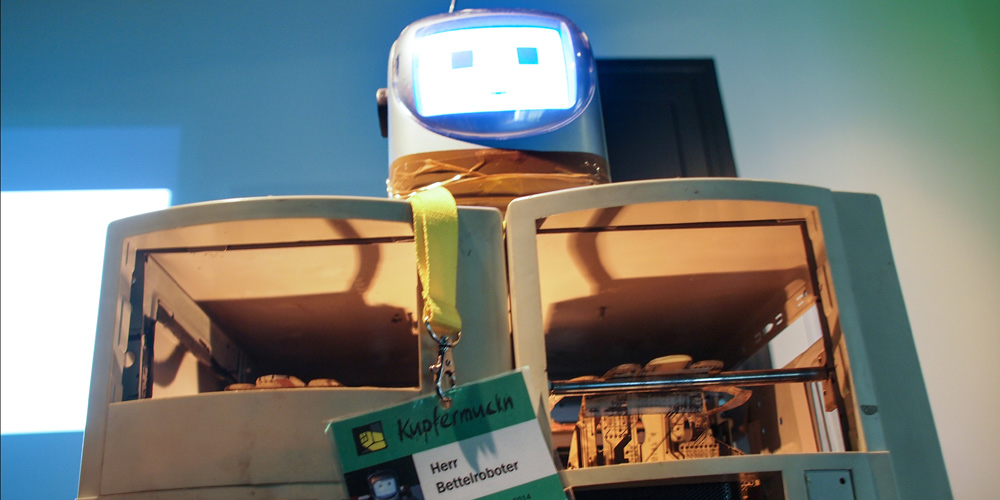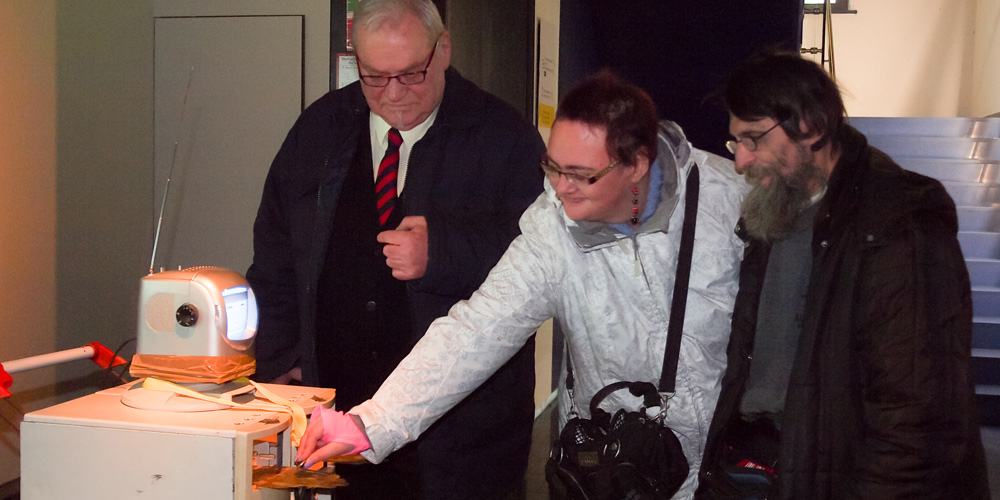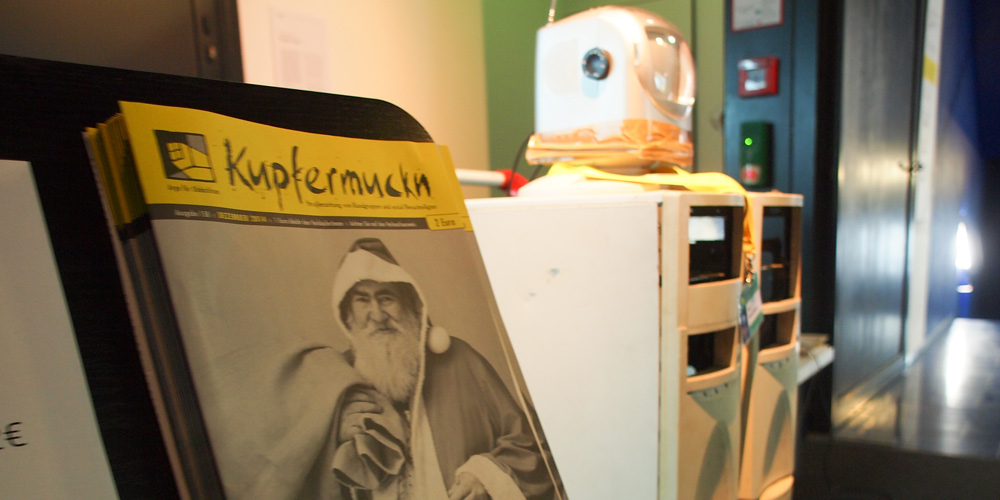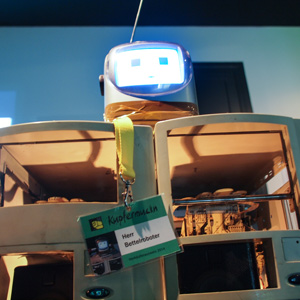
When you enter the Ars Electronica Center’s Device Art exhibition, it’s the first thing you see. Beggar Robotwas constructed out of old hardware by Slovenian artist Sašo Sedlaček. It accosts newcomers, greeting them with open (metallic) arms. Displaying the official badge identifying a vendor of the street paper Kupfermuckn, it politely requests a cash donation. This mechanized campaign has collected more than 250 euros in the past month. And not only in the local currency; the take includes coins from all over the world—Japan to Brazil, Australia to Russia.
Has this open-source project—that anyone can copy/tweak/develop at will and free of charge—succeeded in getting more people to donate? Is it more pleasant than having to look real, live poor people in the eyes? In any case, during the pre-launch testing phase, the project crew observed that this robot tends to be tolerated in locations where human beings afflicted by poverty are told to beat it. We recently sat down with Heinz Zauner, editor-in-chief of Kupfermuckn and head of an advocacy group for the homeless, to talk about the connection between technology and poverty.

A robot as Kupfermuckn vendor—are you happy with this campaign?
Heinz Zauner: The campaign is great, above all because it offers another opportunity to carry on the discourse about a ban on panhandling and to talk about background factors having to do with poverty—and about considering people affected by poverty as human beings and not as a problem. Our Kupfermuckn vendors have a relatively positive image among the general public, and we make a concerted effort to be friendly so it stays that way. We’re not beggars—we’re selling something of value. The people who do this are doing something worthwhile and folks appreciate that. Just consider, for example, this street paper’s print run: in December, we print 50,000 copies; throughout the rest of the year, it’s 30,000 a month. The paper sells for €2 apiece, and the vendor keeps half the proceeds.
How does a street paper deal with new technologies?
Heinz Zauner: The Big Issue, a very well-known street paper in England, has already started selling cards imprinted with a code that can be input online to download the paper in digital form to the reader’s tablet. We’re not that far yet, but we are active on social media sites like Facebook, which we use to test what goes over well and what doesn’t. For instance, the posting “Kupfermuckn has Santa Clauses with real beards” reached more than 3,000 people on Facebook. In this respect, new media are fantastic.
But the proliferation of high-tech also has a negative side, which we’re made aware of most clearly when the unemployment rate goes up. The Kupfermuckn street paper is only one initiative by our advocacy group for the homeless. We also provide counseling, residential care and eviction prevention services, and we operate a second-hand shop. We employ a total of 400 people a year, but the number of those who’d like to work for us is a lot higher than the number we can hire. In this latest economic crisis, this quickly became apparent. Precarious employment, day-laborer jobs, people hired out by leasing firms—these jobs are becoming fewer and fewer, and the ones who hold them are the first to be let go when times get tough. Day-laborers are easy to hire, but an employer will think long and hard about dismissing a well-qualified staff member if it might eventually be hard to recruit a replacement with the same level of expertise. We’re sorely aware of this globalization process and the increasing prevalence of technology. This is the other side of the coin with rising productivity. And these are precisely the people who make up our clientele.

This affects the newspaper business too …
Heinz Zauner: Yeah, this is happening with newspapers too—people are being made superfluous by automation as publications make the transition to digital media. But street papers are still upholding this connection, this human element, and I firmly believe that people will continue to value this in the future. You notice that this attitude is especially strong among older folks. Now, during the Christmas season, we occasionally receive a €10 credit to our bank account, and you can just tell it’s from an elderly lady who’s not so well-off herself and made a special trip to the bank to transfer the funds. I’m not at all concerned about the future of our street paper, but I am very much concerned about the jobs that our people, our clients, might be able to find out there. We have people who like to work and would be delighted to re-enter the workforce. We have a construction worker we hadn’t seen for years, but now he’s resurfaced in the wake of a major company’s bankruptcy. After all, a lot of people want to do something just because it’s a source of dignity.
How did Kupfermuckn actually come about, and how many people are working on this project?
Heinz Zauner: We currently have 130 vendors every month in Linz alone, and there are about 20 more in Wels and Steyr. What makes our paper so unique is that three-quarters of the content is written by the vendors themselves. Our story goes back to 1994, when our association operated a drop-in center for the homeless, and author Kurt Mitterndorfer began to organize writing workshops so the people there also had something to do during the day. Then, Augustin, Austria’s first street paper, was established in Vienna and we wanted to try it out here in Linz too. At first, we distributed 1,500 copies free of charge, and the feedback we got was very positive.
And who writes the articles?
Heinz Zauner: Ever since Kupfermuckn was founded, the editorial staff has met on Wednesday at 1 PM. We have a mission statement and our own bylaws, and workspaces for about 20 writers who want to contribute content. Each gets €40/month, and they have to be present at least half the time. At the editorial staff meetings, they submit their copy and everyone reads his/her own text aloud to the group. This is how we develop themes for the next issue, and we discuss what’s still open and everybody’s to-do list. For instance, Georg from Wels suggested that we all take selfies and post them on Facebook, and this idea of socially disadvantaged men and women taking selfies was very well received. As an editor-in-chief, you often wrack your brain about what would be the best approach to a particular social welfare-related issue, and then you end up getting a terrific idea from one of the people who are actually confronted by it personally in everyday life. We have 2-3 regular employees who are responsible for the logistics and other organizational matters. All the rest is managed by our clients themselves, and they’re paid for it. Naturally, having an income is important but it’s not the most important thing. A lot of people who work with us say that they don’t come for the money but because they’re part of the family. Just like other street papers, we too organize a lot of recreational activities, stuff that doesn’t always make it into print. We work a lot with the men and women who need our help. That’s what distinguishes Kupfermuckn.

Now, during the Yuletide season, your print run is higher, people contribute more generously, and interest on the part of the media increases …
Heinz Zauner: We really shouldn’t be annoyed when, especially now in December, a lot of people want to get our attention. After all, we benefit from the receipts of two mulled wine & grog stands operated by two charitable organizations at Christmas fairs here in the region, we receive contributions from firms and a lot of support from private individuals, much of it anonymous, and we’re invited to dine at various restaurants. Of course, we’re delighted by all the generosity we experience in December but, I must say, we’d be just as happy to receive it in February or April. Especially now when the weather turns cold and Christmas is approaching, the problem of poverty becomes more visible. As soon as the first snow falls, concerned citizens and journalists start calling us and asking how the homeless are doing and whether anybody’s freezing on the streets. But assistance for people looking for a place to live—another area our association is involved in—is needed 365 days a year, not just at Christmas time. And in the summer, when the media publishes stories about how homeless people are a nuisance in city parks, then the empathy isn’t as great. Of course, we’re happy to accept Christmas contributions. There’s a positive side to everything, and now, that’s simply in the Christmas spirit.
The Beggar Robot is still on the job in the Device Art exhibition at the Ars Electronica Center. If you’d like to support the ARGE für Obdachlose homeless advocacy group, information is available online at auf www.arge-obdachlose.at. Donations to benefit socially disadvantaged people are gladly accepted: IBAN: AT461860000010635860 und BIC: VKBLAT2L.
